人教版(2019)必修第二册Unit 4 History and Traditions Reading and thinking 课件(22张ppt)
文档属性
| 名称 | 人教版(2019)必修第二册Unit 4 History and Traditions Reading and thinking 课件(22张ppt) | 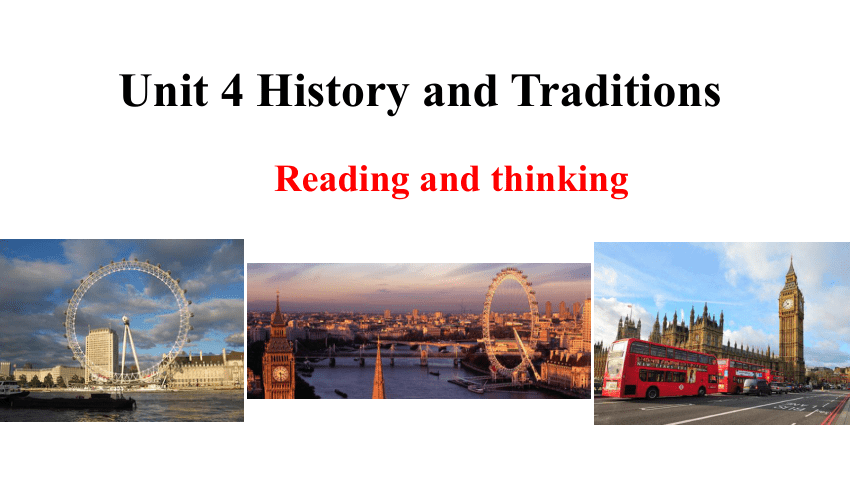 | |
| 格式 | zip | ||
| 文件大小 | 4.2MB | ||
| 资源类型 | 教案 | ||
| 版本资源 | 人教版(2019) | ||
| 科目 | 英语 | ||
| 更新时间 | 2021-12-03 20:18:05 | ||
图片预览

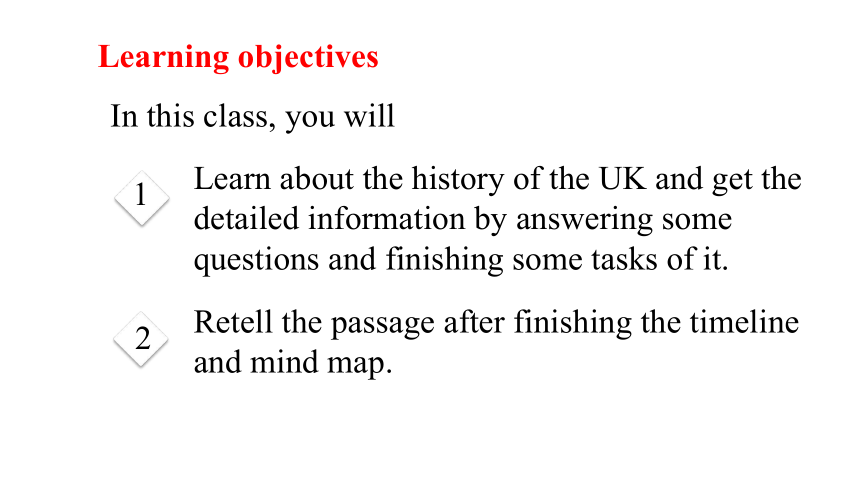
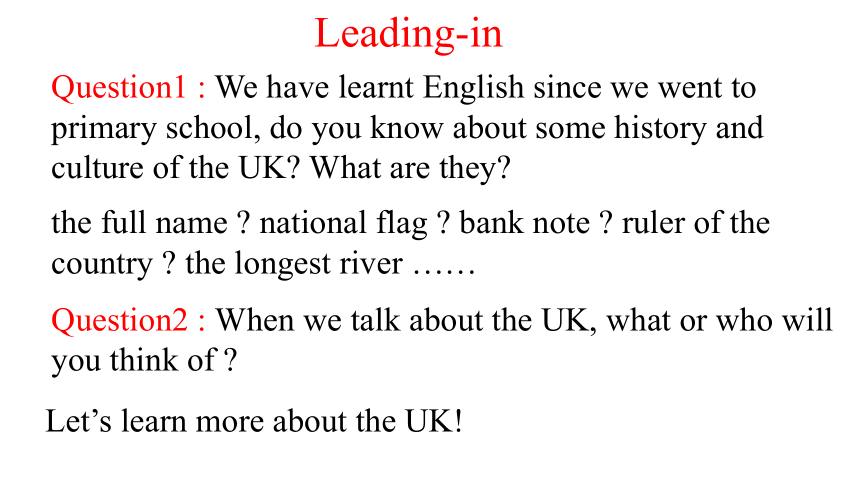
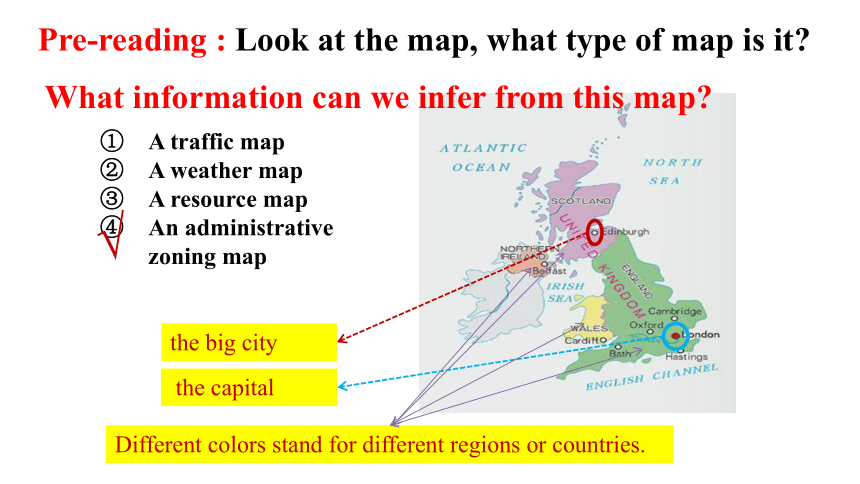
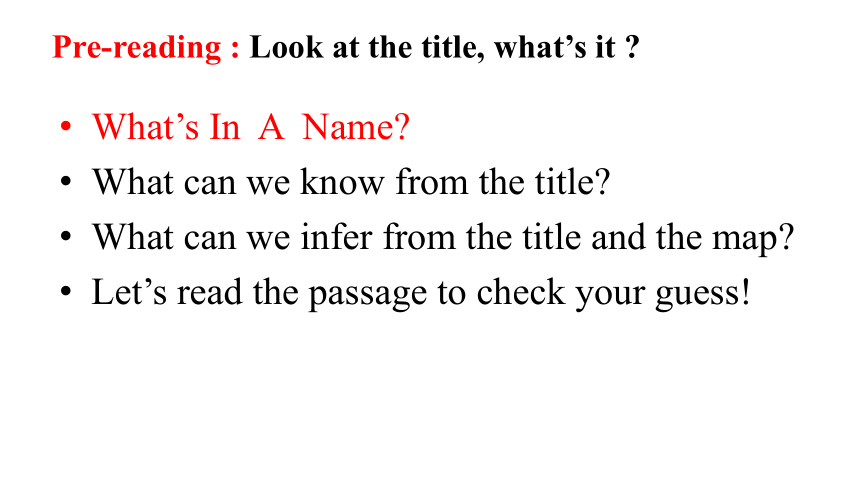

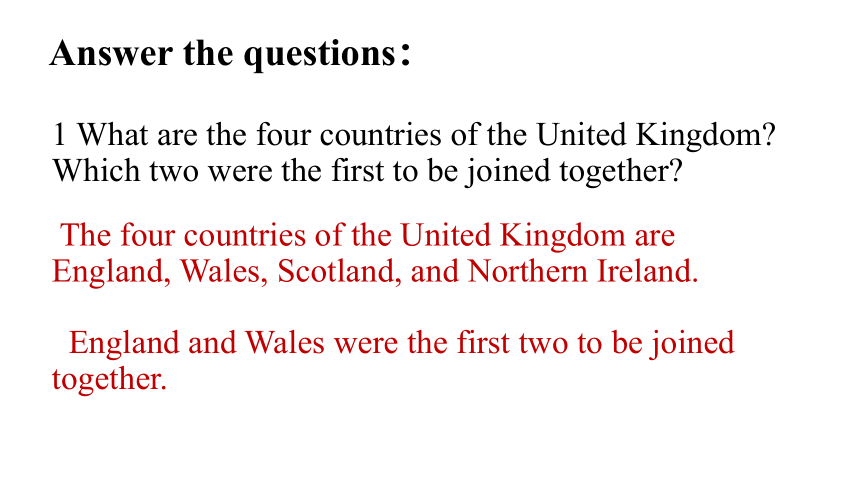
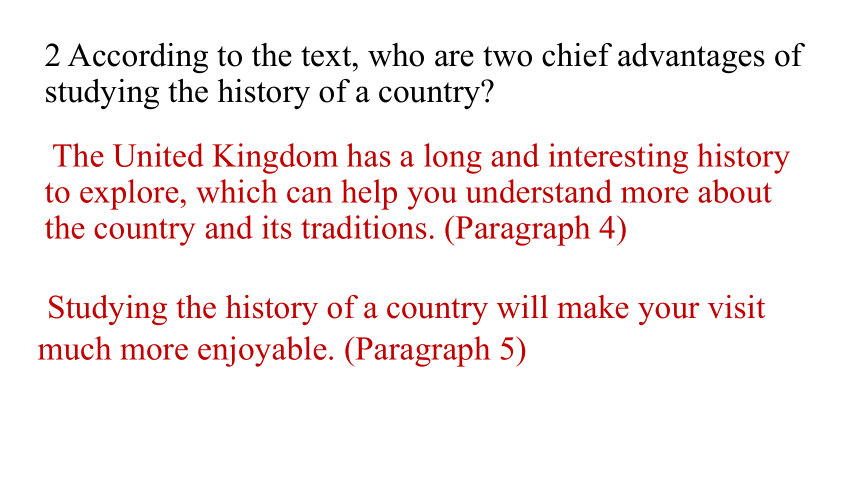
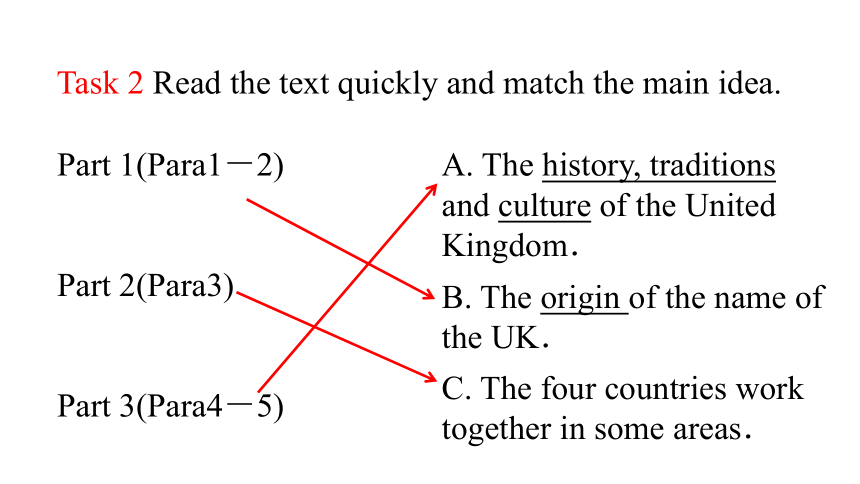
文档简介
(共22张PPT)
Unit 4 History and Traditions
Reading and thinking
1
2
Learning objectives
In this class, you will
Retell the passage after finishing the timeline and mind map.
Learn about the history of the UK and get the detailed information by answering some questions and finishing some tasks of it.
Leading-in
Question1 : We have learnt English since we went to primary school, do you know about some history and culture of the UK What are they
the full name national flag bank note ruler of the country the longest river ……
Question2 : When we talk about the UK, what or who will you think of
Let’s learn more about the UK!
Pre-reading : Look at the map, what type of map is it
A traffic map
A weather map
A resource map
An administrative zoning map
√
the big city
the capital
Different colors stand for different regions or countries.
What information can we infer from this map
What’s In A Name
What can we know from the title
What can we infer from the title and the map
Let’s read the passage to check your guess!
Pre-reading : Look at the title, what’s it
1 What are the four countries of the United Kingdom Which two were the first to be joined together
2 According to the text, who are two chief advantages of studying the history of a country
Fast reading (3mins)
Task1.Read the text quickly and answer the questions: Underline the answers on your books.
1 What are the four countries of the United Kingdom Which two were the first to be joined together
Answer the questions:
The four countries of the United Kingdom are England, Wales, Scotland, and Northern Ireland.
England and Wales were the first two to be joined together.
2 According to the text, who are two chief advantages of studying the history of a country
The United Kingdom has a long and interesting history to explore, which can help you understand more about the country and its traditions. (Paragraph 4)
Studying the history of a country will make your visit much more enjoyable. (Paragraph 5)
Task 2 Read the text quickly and match the main idea.
A. The history, traditions and culture of the United Kingdom.
C. The four countries work together in some areas.
Part 1(Para1-2)
Part 2(Para3)
Part 3(Para4-5)
B. The origin of the name of the UK.
Task 3. What is the main idea of the text
A brief introduction to the UK about the__________ of its different names, its __________,________,________,and_________.
formation
history
traditions
culture.
origins
Read Paragraph 1 and answer the following questions. (2mins)
How many names are used to refer to the UK and what are they?
What does the author suggest to solve this puzzle?
Four names are used, the United Kingdom, Great Britain, Britain and England.
Get to know a little bit about British history.
Careful reading
Introduction How to solve the ①_________ caused by the different names
Getting to know a little bit about British history.
puzzle
Careful reading Para.1
How did the UK come into being in the ②_______ century Wales was joined to the kingdom of England.
in the③_______ century Scotland was joined to ④__________ the kingdom of Great Britain.
in the 19th century The kingdom of Ireland was ⑤__________to create the United Kingdom of Great Britain and Ireland.
England
Wales
Scotland
Ireland
16th
18th
create
added
Para.2 Fill in the blanks according to the text(4mins).
How did the UK come into being in the ⑥ ______ century The southern part of Ireland broke away from the UK, which resulted in the full name: the United Kingdom of Great Britain and Northern Ireland.
England
Wales
Scotland
Northern Ireland
Southern Ireland
20th
Para.2 Fill in the blanks according to the text.
para 3. Similarities
Differences
Para3. What are the similarities and differences of these countries (3mins)
flag, currency and
military defense
education system,
legal system,
traditions and
football teams
Peoples
The Romans
The Anglo-Saxons
The Vikings
The Normans
Time
in 1st century
in 5th century
in 8th century
in 11th century
Building towns and roads
Introducing English, changing the way people built houses
Achievements
Leaving behind lots of new vocabulary and location names
Having castles built, changing legal system, introducing French into English
Para 4
(3mins)
Four different groups of people who took over the UK in turn throughout history and their influence on the history of the UK.
Summary the capital city London an ___________ port city; countless historic sites; lots of the museums
the UK a fascinating _____________ of history and modern culture
ancient
mix
Para5.Fill in the blanks according to the text.(2mins)
Vikings came
Anglo-Saxons came
Romans arrived
11th century
16th century
18th century
19th century
20th century
1st century
towns and roads
5th century
language and the way people built houses
8th century
vocabulary and names of locations across the UK
Normans conquered England after the Battle of Hastings
castles built, legal system changed, and new words from French introduced
Wales was joined to Kingdom of England
Scotland was joined to England and Wales
“Kingdom of Great Britain” was formed/created
Ireland was added
“United Kingdom of Great Britain and Ireland” was formed.
the southern part of Ireland broke away
the name changed to “United Kingdom of Great Britain and Northern Ireland”
What changed?
What happened?
When?
Review the main time and things
Using
the
timeline
Pair work
Make conversations with your desk mates by asking questions on the timeline above.
For example:
A :In this passage, what happened in the history of the UK in the 1st century And what changed
B:In the 1st century, Romans arrived there and built towns and roads.
A:What about in the 5th century And what changed
B:In the 5th century,……
Post-reading :Draw a mind map of yourself about the passage. You can add details if necessary , then retell it for us.
_________________
_________________
Possible version
Homework: Thinking and writing
What important things should visitors know about before they come to China
For example, HongKong of China.
Find more materials and information about the history of HongKong of China after class, then write a passage by immitating the text .
Thank you for your attention!
Unit 4 History and Traditions
Reading and thinking
1
2
Learning objectives
In this class, you will
Retell the passage after finishing the timeline and mind map.
Learn about the history of the UK and get the detailed information by answering some questions and finishing some tasks of it.
Leading-in
Question1 : We have learnt English since we went to primary school, do you know about some history and culture of the UK What are they
the full name national flag bank note ruler of the country the longest river ……
Question2 : When we talk about the UK, what or who will you think of
Let’s learn more about the UK!
Pre-reading : Look at the map, what type of map is it
A traffic map
A weather map
A resource map
An administrative zoning map
√
the big city
the capital
Different colors stand for different regions or countries.
What information can we infer from this map
What’s In A Name
What can we know from the title
What can we infer from the title and the map
Let’s read the passage to check your guess!
Pre-reading : Look at the title, what’s it
1 What are the four countries of the United Kingdom Which two were the first to be joined together
2 According to the text, who are two chief advantages of studying the history of a country
Fast reading (3mins)
Task1.Read the text quickly and answer the questions: Underline the answers on your books.
1 What are the four countries of the United Kingdom Which two were the first to be joined together
Answer the questions:
The four countries of the United Kingdom are England, Wales, Scotland, and Northern Ireland.
England and Wales were the first two to be joined together.
2 According to the text, who are two chief advantages of studying the history of a country
The United Kingdom has a long and interesting history to explore, which can help you understand more about the country and its traditions. (Paragraph 4)
Studying the history of a country will make your visit much more enjoyable. (Paragraph 5)
Task 2 Read the text quickly and match the main idea.
A. The history, traditions and culture of the United Kingdom.
C. The four countries work together in some areas.
Part 1(Para1-2)
Part 2(Para3)
Part 3(Para4-5)
B. The origin of the name of the UK.
Task 3. What is the main idea of the text
A brief introduction to the UK about the__________ of its different names, its __________,________,________,and_________.
formation
history
traditions
culture.
origins
Read Paragraph 1 and answer the following questions. (2mins)
How many names are used to refer to the UK and what are they?
What does the author suggest to solve this puzzle?
Four names are used, the United Kingdom, Great Britain, Britain and England.
Get to know a little bit about British history.
Careful reading
Introduction How to solve the ①_________ caused by the different names
Getting to know a little bit about British history.
puzzle
Careful reading Para.1
How did the UK come into being in the ②_______ century Wales was joined to the kingdom of England.
in the③_______ century Scotland was joined to ④__________ the kingdom of Great Britain.
in the 19th century The kingdom of Ireland was ⑤__________to create the United Kingdom of Great Britain and Ireland.
England
Wales
Scotland
Ireland
16th
18th
create
added
Para.2 Fill in the blanks according to the text(4mins).
How did the UK come into being in the ⑥ ______ century The southern part of Ireland broke away from the UK, which resulted in the full name: the United Kingdom of Great Britain and Northern Ireland.
England
Wales
Scotland
Northern Ireland
Southern Ireland
20th
Para.2 Fill in the blanks according to the text.
para 3. Similarities
Differences
Para3. What are the similarities and differences of these countries (3mins)
flag, currency and
military defense
education system,
legal system,
traditions and
football teams
Peoples
The Romans
The Anglo-Saxons
The Vikings
The Normans
Time
in 1st century
in 5th century
in 8th century
in 11th century
Building towns and roads
Introducing English, changing the way people built houses
Achievements
Leaving behind lots of new vocabulary and location names
Having castles built, changing legal system, introducing French into English
Para 4
(3mins)
Four different groups of people who took over the UK in turn throughout history and their influence on the history of the UK.
Summary the capital city London an ___________ port city; countless historic sites; lots of the museums
the UK a fascinating _____________ of history and modern culture
ancient
mix
Para5.Fill in the blanks according to the text.(2mins)
Vikings came
Anglo-Saxons came
Romans arrived
11th century
16th century
18th century
19th century
20th century
1st century
towns and roads
5th century
language and the way people built houses
8th century
vocabulary and names of locations across the UK
Normans conquered England after the Battle of Hastings
castles built, legal system changed, and new words from French introduced
Wales was joined to Kingdom of England
Scotland was joined to England and Wales
“Kingdom of Great Britain” was formed/created
Ireland was added
“United Kingdom of Great Britain and Ireland” was formed.
the southern part of Ireland broke away
the name changed to “United Kingdom of Great Britain and Northern Ireland”
What changed?
What happened?
When?
Review the main time and things
Using
the
timeline
Pair work
Make conversations with your desk mates by asking questions on the timeline above.
For example:
A :In this passage, what happened in the history of the UK in the 1st century And what changed
B:In the 1st century, Romans arrived there and built towns and roads.
A:What about in the 5th century And what changed
B:In the 5th century,……
Post-reading :Draw a mind map of yourself about the passage. You can add details if necessary , then retell it for us.
_________________
_________________
Possible version
Homework: Thinking and writing
What important things should visitors know about before they come to China
For example, HongKong of China.
Find more materials and information about the history of HongKong of China after class, then write a passage by immitating the text .
Thank you for your attention!
